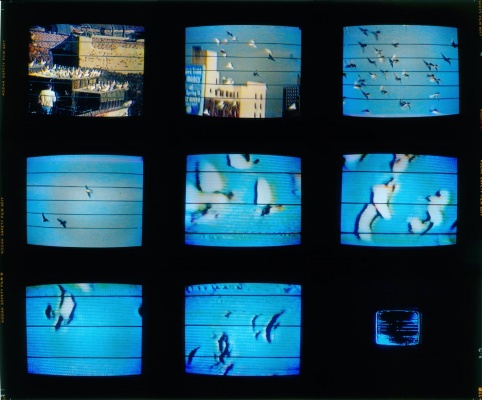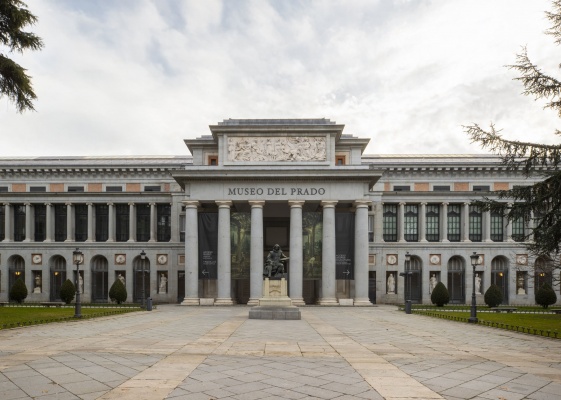Descripción de la Exposición
La primera muestra individual en España del artista Álvaro Urbano (Madrid, 1983), "El despertar", fue una coproducción entre Acción Cultural Española (AC/E), Storefront for Art and Architecture y La Casa Encendida. La instalación, creada originalmente por el artista para La Casa Encendida, se mantuvo en esta sede durante 2020 y 2021, tiempo durante el que tuvo que cerrar entre medias debido a la pandemia, con el objetivo de hacer una reflexión en torno a los diferentes imaginarios de las arquitecturas abandonadas.
Para su segunda sede en Storefront for Art and Architecture en Nueva York, la exposición toma el nombre de The Great Ruins of Saturn, #greatruinsofsaturn. En ella, Urbano, continuando con la temática de “El despertar", presenta una película y una instalación que resurgen de manera lúdica y satírica historias del parcialmente abandonado Pabellón del Estado de Nueva York (conocido como ‘Tent of Tomorrow’), un recinto ferial que hace 57 años presentó al mundo los logros del progreso tecnológico. La obra de Urbano sitúa el pabellón abandonado en un teatro ocupado por un elenco de personajes inanimados, dándoles vida para cuestionar las nociones obsoletas y contemporáneas de crecimiento y el desarrollismo.
El recinto ferial de 650 acres estuvo poblado por cientos de estructuras temporales y asistieron 51 millones de personas hace 57 años. En medio de todas las atracciones, el colosal Pabellón del Estado de Nueva York, con su diseño de la era espacial y sus derechos como el pabellón más grande y más alto de la feria, encarnaba el espectáculo de los "logros del hombre" (o de los de ciertos hombres, como el Gobernador Nelson Rockefeller, el presidente de la Feria Mundial, Robert Moses, y el arquitecto del pabellón Philip Johnson).
57 años después, este símbolo que alguna vez fue colorido y que buscaba proyectar la visión definitiva del progreso, el optimismo y el poder, permanece en gran parte inactivo. Su vestigio de hormigón ahora proyecta sombras sobre su entorno... y su visión original. Mientras que otras estructuras de la feria han sido reutilizadas, rehabilitadas y trasladadas a varios sitios, el Pabellón del Estado de Nueva York, con su estructura central conocida como la Carpa del Mañana, aún espera su gran partida.
Comisariado: José Esparza, Chong Cuy
-------------------
“Man’s Achievements on a Shrinking Globe in an Expanding Universe” stated the dedication of the 1964 New York World’s Fair, held at Flushing Meadows Corona Park – once a sprawling ash dump in the heart of the borough of Queens.
The 650-acre fair site was populated by hundreds of temporary structures and attended by 51 million people. Amidst all the attractions, the colossal New York State Pavilion, with its space age design and its boasting rights as the largest and tallest pavilion at the fair, embodied the spectacle of “man’s achievements” (or of those by certain men, such as Governor Nelson Rockefeller, World’s Fair President Robert Moses, and pavilion architect Philip Johnson).
57 years later, this once colorful symbol that sought to project the ultimate vision of progress, optimism, and power lies largely dormant. Its concrete vestige now casts shadows upon its surroundings...and its original vision. While other structures from the fair have been repurposed, rehabilitated, and moved to other sites, the New York State Pavilion, with its central structure known as the Tent of Tomorrow, still awaits its grand departure.
The Great Ruins of Saturn by artist Alvaro Urbano speculates upon its unknown future. Through the technique of shadow puppetry, Urbano presents a film and an installation that playfully and satirically resurface stories from the Tent of Tomorrow and its politically and socially charged past. Urbano’s work situates the neglected pavilion in a theater occupied by a cast of inanimate characters, bringing them to life in order to question both obsolete and contemporary notions of growth and development.
Untethered from its original site, the building relinquishes the bright lights of achievement and instead seeks an otherworldly ending. In the process, it escapes the shadows formed by the still-thriving promises of a techno-capitalist future.
___________________________
Alvaro Urbano (b. 1983, Madrid, Spain) is a visual artist based in Berlin. He studied at the Escuela Técnica Superior de Madrid (ETSAM) and the Institut für Raumexperimente of the Universität der Künste in Berlin. He is currently a professor at the École Nationale Supérieure des Beaux-Arts in Paris.
Urbano’s practice embraces a variety of media, from performance to spatial installations that unfold throughout an experimental process. Often using architecture, theatre, and heterotopia as points of departure, his work invites dialogue in newly conceived environments – exposing conflicts between reality and fiction that redefine and render time-space based situations. Recently, his work has explored and researched the futures of abandoned and vacant World’s Fair pavilions, as in his 2020 show The Awakening at La Casa Encendida (Madrid), which animated the 1958 Spanish Pavilion in Brussels.
Other recent exhibitions and projects have been shown at Travesía Cuatro, Madrid; Neue Nationalgalerie, Berlin, Germany, Art Basel Statements, Switzerland, with ChertLüdde; Bundeskunsthalle, Bonn, Germany; Kunsthalle Düsseldorf, Germany; Boghossian Foundation, Brussels, Belgium; Kölnischer Kunstverein, Cologne, Germany; Hamburger Bahnhof, Berlin, Germany; CAB, Brussels, Belgium; Moscow International Biennale for Young Art, Moscow, Russia; PAC, Padiglione d’Arte Contemporanea, Milan, Italy; among others.
He has presented his collaborative work with Petrit Halilaj at Autostrada Biennale, Prishtina, Kosovo; the 17th Quadriennale di Roma, Italy; Palacio de Cristal/Reina Sofía Museum, Madrid; Biennale Gherdëina, in Ortisei, Italy and S.A.L.T.S., Basel, Switzerland.
The Great Ruins of Saturn is Urbano’s first solo exhibition in the U.S.

Exposición. 08 may de 2025 - 14 sep de 2025 / MNAC - Museu Nacional d'Art de Catalunya / Barcelona, España

Formación. 30 oct de 2025 - 11 jun de 2026 / Museo Nacional del Prado / Madrid, España